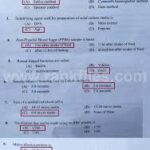In the vast sea of the internet, numbers often carry more weight than names. IP addresses are the digital DNA of our online world, representing everything from personal devices to massive data centers. But not every IP address is what it seems. Some, like 264.68.111.161, raise eyebrows and spark curiosity—because they simply shouldn’t exist. Despite resembling a valid IPv4 address, this combination of numbers lies outside the accepted numerical range, making it both technically invalid and fascinating to examine.
Understanding what 264.68.111.161 is—and more importantly, what it isn’t—opens a portal into the world of networking, internet protocols, and cybersecurity. Whether you’re a casual browser, a network engineer, or a digital detective, this strange address holds more intrigue than first meets the eye.
What Is an IP Address, Really?
Before digging into the specifics of 264.68.111.161, it’s crucial to understand what an IP address is. In the simplest terms, an IP (Internet Protocol) address is a numerical label assigned to each device connected to a network. These addresses allow devices to find and communicate with one another. Just as every home has a unique street address, every connected device—your laptop, phone, or router—has a unique IP address.
There are two main versions of IP: IPv4 and IPv6. IPv4, the older version, consists of four octets separated by periods, with each octet ranging from 0 to 255. This means a valid IPv4 address must follow the format of something like 192.168.1.1, where no number exceeds 255. That’s where 264.68.111.161 begins to raise questions.
Why 264.68.111.161 Is Not a Valid IP Address
From a purely technical standpoint, 264.68.111.161 cannot be a functional IPv4 address because the number 264 exceeds the maximum limit of 255 for any octet. Each section in a dotted decimal address must lie between 0 and 255 inclusive. This rule ensures proper translation and routing of data packets across networks.
So, any attempt to use 264.68.111.161 as a destination or source IP in network settings, command-line tools, or DNS resolution processes will return an error or fail silently. It’s like typing in a fake address into your GPS—it leads nowhere.
Common Mistakes with IP Addresses
One possible explanation for seeing 264.68.111.161 in logs, databases, or user reports is that it was simply a typo or error in data entry. It could have been meant to be 254.68.111.161 or even 192.168.111.161, both of which are valid addresses. In systems where data is collected automatically—such as security monitoring tools, analytics platforms, or server logs—improper sanitization or validation might allow this malformed IP to slip through and get stored.
There’s also the possibility that this address was generated or spoofed as part of a test, simulation, or even a malicious obfuscation attempt. Since it doesn’t resolve or link to anything legitimate, it might be used to mask a bot, confuse analytics systems, or throw off intrusion detection software.
The Role of Invalid IPs in Cybersecurity
Invalid IP addresses, though non-functional, can sometimes play a role in cybersecurity tactics, both defensive and offensive. In honeypot networks, which are set up to detect or mislead attackers, fake IP addresses like 264.68.111.161 might be used to simulate traffic or lure malicious actors into engaging with dead-end nodes.
On the flip side, attackers may inject non-routable or broken IP addresses into logs, headers, or forms to attempt log poisoning, a method of corrupting logs so real intrusions are harder to trace. While 264.68.111.161 won’t ever connect to a real server, it might still appear in suspicious activities or as a digital breadcrumb in a larger exploit.
The Psychology of Digital Oddities
Part of what makes an address like 264.68.111.161 fascinating is the psychological effect of encountering something that looks familiar but isn’t quite right. We’re trained to recognize IP addresses as legitimate strings, so when one breaks the mold—while still looking plausible—it creates a feeling of unease or curiosity. Is it a secret server? A hidden government node? A sign of a deeper system flaw?
Of course, the answer is usually more mundane: a glitch, a typo, or a simulation artifact. But in a world where conspiracy theories often thrive on strings of numbers, an address like this can become a digital urban legend, shared across forums and whispered about in cybersecurity circles.
How Network Tools React to 264.68.111.161
If you attempt to ping 264.68.111.161 using standard networking tools, you’ll get an immediate error. Tools like ping, traceroute, or nslookup will flag it as invalid input. However, certain logging software or open-source analysis tools may still accept and store it, especially if they don’t validate inputs robustly.
Firewalls, proxies, and intrusion detection systems will typically ignore or reject packets labeled with malformed IPs, though in some rare configurations, they may log the attempt and raise a flag. This can be useful when identifying botnets or poorly coded scanners probing for weaknesses across the web.
Could This Be an IPv6 Translation?
Some might wonder if the strange address could be part of a collapsed IPv6 notation or incorrectly formatted address used in transition technologies. IPv6 uses a much more complex format, often including hexadecimal characters and colons, like 2001:0db8:85a3:0000:0000:8a2e:0370:7334.
However, 264.68.111.161 doesn’t match any IPv6 syntax or compressed mapping structure. It remains purely an invalid IPv4 address, and any attempt to translate it across protocols will result in a failed conversion or discarded input.
The Curiosity Factor: Why It Keeps Popping Up
Even though it’s invalid, the address 264.68.111.161 sometimes appears in online search results, error reports, or anecdotal accounts. This often comes from forums discussing strange IPs in their server logs, or from automated tools that generate sample data without enforcing validation rules.
In educational materials or fake demo datasets, invalid IPs might be used intentionally to avoid pointing to a real-world host, thus reducing legal risk or security exposure. It’s similar to how “123.456.789.000” is used in memes or placeholder guides—it looks real but leads nowhere.
Educational Use and Examples
For instructors and students in network security or data science, using obviously invalid IPs like 264.68.111.161 can help identify flawed validation logic or poorly constructed datasets. Exercises might include:
-
Writing regex patterns to exclude invalid octets
-
Filtering malformed IPs in CSV or log files
-
Debugging systems that accept invalid network configurations
In this way, 264.68.111.161 becomes a teaching tool as well as a curiosity.
Digital Ghosts in the Internet Landscape
As more automated systems operate across the digital landscape, small glitches like 264.68.111.161 become increasingly common. Whether it’s due to human error, outdated databases, or purposeful misdirection, these non-functional addresses float through cyberspace like digital ghosts—visible but untouchable.
They represent the quirks of a complex system where not everything is clean, perfect, or predictable. They remind us that the internet is not just a precise machine, but also a human-made, human-maintained ecosystem full of anomalies and accidents.
Conclusion
The address 264.68.111.161 may not lead to any real server, website, or device, but it leads us somewhere just as interesting—into the heart of how we perceive data, validate inputs, and assign meaning to numbers. While technically invalid, this IP address has become a talking point for networking enthusiasts, cybersecurity professionals, and digital explorers.
In a way, 264.68.111.161 is a symbol of everything that lies beneath the surface of the internet. It’s a reminder that not everything we see online is real, valid, or functional—but that even errors can spark curiosity, learning, and a deeper appreciation of the digital world.










